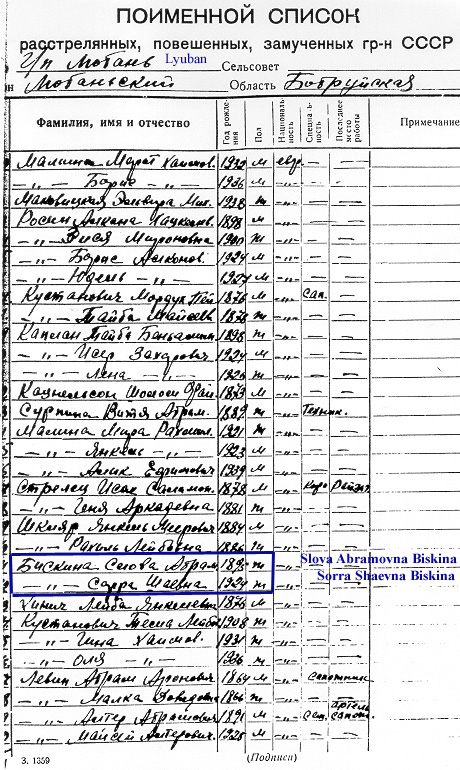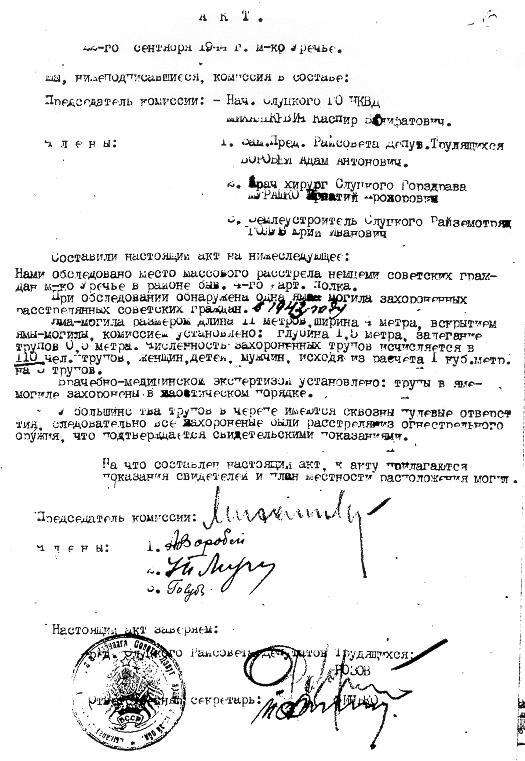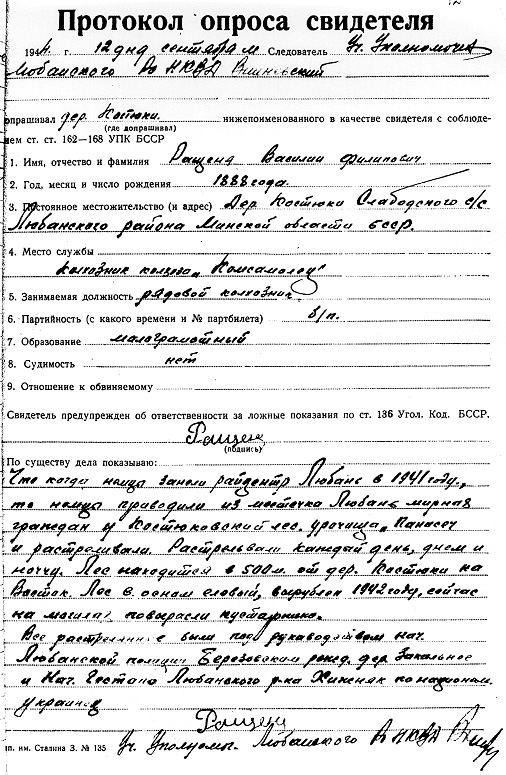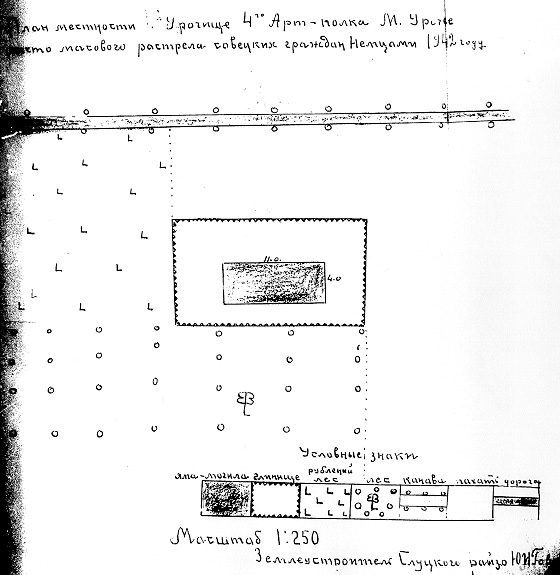This web page is intended to be a brief guide to obtaining and understanding records from the Soviet Commission that investigated and documented the atrocities that occurred during the German Occupation of Russia from 1941-1944. The formal name of the Commission was the Extraordinary State Commission to Investigate and Establish War Crimes of the German-Fascist Invaders. This name comes from the documents themselves. In catalogs and other listings that I have seen, the word 'Invaders' does not appear. I think it's worthy of inclusion, since it is the only word that gives the unique Soviet perspective, and their sense of raw anger [read the Molotov Notes on German Atrocities]. The records are originally from the Central State Archive of the October Revolution in Moscow, which is now called State Archive of the Russian Federation. The records are available at Yad Vashem and the United States Holocaust Memorial Museum (USHMM). At USHMM, which is what I will focus on, the records are a 27-reel collection of microfilm known as RG-22.002M.
The records are of both genealogical and historical interest because they contain numerous lists of Jewish victims as well as testimonies of witnesses and townspeople to the specific Nazi actions in a given locale. Background information on the nature of the records themselves is contained in the Bibliographic Resources section of this web page.
As an example of what information is available, this page contains a link to the List of Holocaust Victims from Glussk that was extracted from the Extraordinary State Commission records. The Glussk list was originally in typed Cyrillic.
Caution: All of my comments are based on reviewing 2 reels out of a 27 reel collection. It may be that these two reels were uniquely constructed, and my comments would therefore only be appropriate to these two reels. Or they may apply to the collection as a whole.
Guide to Accessing the Records
Here is the step-by-step process that worked for me.
Step 1:
Compile a list of towns for which you are interested in obtaining records.
In my case, I was looking for information on three towns in the district (uezd) of Bobruisk,
Minsk Gubernia: Urechye, Tal and Lyuban. It is important to know that the towns in this
resource are generally organized according to the town's Soviet administrative hierarchy, not its Czarist-era
administrative hierarchy. Therefore, while you may already know the uezd (district) and gubernia
for your town(s)
in Czarist times, you will want to know the raion (region) and Oblast (province) for
each town instead. For example, Urechye was in the uezd of Bobruisk,
Minsk Gubernia before 1918, but during WWII, it was part of Slutsk raion, Minsk Oblast.
If you don't know this information, you can still succeed, but it may take a little more
effort, and thus a little more time.
Step 2:
Consult the town index of 1,450 localities covered by the reports, which appears in
Appendix C of Gary
Mokotoff's "How to Document Victims and Locate Survivors of the Holocaust" (Avotaynu, 1995).
This list shows the Oblast for each town, but not the raion. Tip: This index has some errors in it. While I found Lyuban in the town index easily
enough, Urechye was incorrectly spelled Rechy'e and Tal was incorrectly spelled Talyy.
I use the word 'incorrect' because these deviations go beyond the normal town name variations.
The existence of additional errors was confirmed for me by Mr. Vadim Altskan, a professional archivist at
USHMM, who indicated there were a number of mistakes in the town index, which was compiled
by museum volunteers. From my examination of the actual records, the list also appears to be
a little incomplete. However, the towns I found in the records that are not in the index
were hard to read, and there was relatively little information for them.
My recommendation to someone who has not thoroughly studied their region(s) of interest is to note any town names in Appendix C that loosely match towns of interest and make further inquiries at USHMM. Tip: Be sure to note nearby towns to those of interest, for a number of reasons. First, your town may not be included in the index. Second, in the material I reviewed, there were generally references to nearby towns in the Akty and witness statements. Third, Jews were sometimes moved from one town to another in consolidating ghettos, and labor camps. So if you are looking for Holocaust victims, they may have died in a town other than their town of residence, and might appear on a nearby town's victim list. Summary: The town index in Appendix C is an important list, and one that should be carefully reviewed before contacting USHMM.
When I reviewed the inventory, it provided only a rudimentary listing of the contents of each reel, with some errors, but it was detailed enough to suggest that Reel 24 was the reel I should make further inquiries about. Since Urechye and Tal were not mentioned in the USHMM inventory of Reel 24, I confirmed with archivists at USHMM that Reel 24 had the specific towns I wanted. Tip: Print out the contents of the inventory for the reel(s) you need.
From what I've seen, there is a basic sequence to the contents of most files.
First is a title card that
describes the file and indicates Fond-opis-file number. This is followed by Akty, literally deeds or documents, which
represent official findings of the local NKVD
* NKVD = People's Commissariat for Internal Affairs (precursor agency to KGB).
Some comments may be of use:
Go back to Index
This section shows samples of selected types of document formats that are found in the records.
It's not a complete set of document types, but includes some that are more geneaologically
interesting ones.
The four items below the title are
(clockwise from upper left): selo (town), sel'sovet, oblast, raion.
They are the administrative hierarchy for the town whose victim list is presented. Of these,
selo is used as a generic term. That is, the town may be a selo, or it may instead be a derevnya,
gorod, mestechko, etc. There will generally be an indication of which type.
These terms are simply different administrative categories for the type of
town. Because space was at a premium, if the list for one town ends somewhere in the page,
the list for the next town may begin directly after it. These four items may therefore be
found somewhere in the page, and it may be the only reference to the town name. So
scan carefully if you have not found the town you are looking for.
The main columns of information
from left to right are: Name (last, first, patronymic), year of birth, gender, Nationality (this page
indicates all "ebp", cyrillic for evrei or 'Jew'), occupation, last place of work.
From what I have seen, the patronymic, occupation and last place of work are most likely to be
only sporadically filled in. The two names outlined in blue are relatives of mine.
Then there is a statement of what was learned from the witness.
Go back to Index
Go back to Index
Sample Images of Records
The first type of document is what I call a victim list.
Its actual title translates to "Namelist of Soviet Citizens executed (by firing squad),
hanged, or tortured". The vast majority of citizens on these lists were Jewish
and sometimes they are explicitly identified as such (see Nationality below).
From what I have seen, the victim list may very well be the most common type of document.
An earlier examiner of these records commented that these lists represented a "negative census".
This particular page is a victim list for the town of Lyuban, in Bobruisk Oblast.
Though many of the victim lists used this standard form, in some cases they ran out of the form.
In that case, either
a substitute form was relabeled and used, or the column headers, title, and so forth were
simply handwritten on a blank or lined sheet of paper.

This page is an example of an Akt, or official finding by the local NKVD committee, who signed their
names at the bottom of the page. This particular Akt documents the discovery of one of three
mass grave sites where the citizens of Urechye were buried. The document appears to indicate
that the grave site was found near Urechye in the former operational area of the 4th artillery polk (regiment).
It describes in detail the length, width and depth of the grave pit, and says 110 bodies are buried there. Judging
by the round numbers used to account for victims in this and other such findings, and the number of years
that passed between atrocity and the documentation of it, it appears that these numbers are estimates
based on grave site dimensions, rather than actual counts.

This page shows another standard form, the Protokol, used to interrogate/question
witnesses and others. The preliminary information is the date and the name of the investigator,
followed by the subject of the interrogation.
The first 9 numbered items are personal information about the witness:

This page is an example of a schematic map drawn to show the site of the same mass grave
in Urechye talked about in the Akt example above. The dark rectangle in the middle is the mass grave,
11x4 meters, surrounded by clay. The legend at the bottom shows the various elements in the schematic.
From left to right the first five boxes represent: mass grave, clay, chopped-down forest,
living forest, and trench. The scale of the schematic is 1:250.

This page is an example of a standard form titled "Summary of Information".
It is a spreadsheet-like summary of victims from a given region. It
may be for an individual raion as in this example, or it may be for an entire oblast and
contain several rows, one for each raion. This sample, for Lyuban raion,
shows only columns 2-12. Column 2 is the name of the raion. Columns 4-6 indicate the numbers
executed by total, women, children. Columns 7-9, and 10-12 do the same for those hanged and
burned respectively.

Notes on Reel 24
This section has notes
on the information contained on Reel 24 of the collection.
Reel 24 covers selected areas of what is now Belarus and smaller parts of neighboring countries.
Approximate coverage would be as follows: Vilna in the Northwest to Bobruisk in the Northeast
to Mozyr in the Southeast to Pinsk in the Southwest. However, relatively few towns are
covered within these boundaries on the reel. There are other reels in the set that contain information on
Belarus as well.
Counter #'s are obtained by resetting the microfilm reader counter to 0 on the first
filmed frame. (They are approximate).
7021-82 Belarus, Bobruisk Oblast
Begins at counter #890.
7021-82-3 Kirov Region
Begins at counter #1070.
7021-82-4 Gressk Region
Begins at counter #1114. Includes victim lists for towns of Gressk and Grozovo only. There are
missing pages.
7021-82-5 Lyuban and Osipovichi Regions
Begins at counter #1142.
Lyuban victim list begins at #1164. About 57 pages. Includes Lyuban and many of the
smaller nearby towns: Kostiuki, Osovets, Tal. Page 13-38 is for Lyuban. Page 45 is
Kostiuki, Page 66 is Osovets, Page 54-55 is Tal. In many of these smaller towns, none of the victims
are Jewish. Almost all the Lyuban victims are Jewish. Some pages were filmed more than once.
7021-82-6 Glussk and Oktyabrsky Regions
Begins at counter #1226. Glussk victim list begins at #1239 and is typed Cyrillic.
Includes Dokol (pg. 33), Gorodok (pp. 33-35), Simonovichi (pp. 40-45), Glussk (pp. 45-80)
7021-82-7 Starobin Region
Begins at counter #1286.
7021-82-8 Staryia Dorogi and Kopyl Regions
Begins at counter #1344.
7021-82-9 Slutsk and Slutsk Region
Begins at counter #1415. Slutsk victim list begins at #1439. Urechye victim list begins at
#1454 (page 59-69 of Slutsk list).
7021-81-106 Byten, Gorodishche, Dyatlovo, Ivenets, Pletsk, Karelichi, Mir and Novogrudok regions
Mir begins at counter #2185. There are several lengthy, well-preserved victim lists in
the Baranovichi Oblast file.
Dyatlovo, Ivenets, Mir, Gorodische, Novogrudok are examples.
Bibliographic Resources